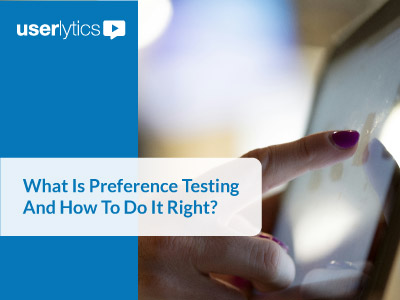By Mark Hall, Guest Blogger.
An e-commerce and Customer Research Expert who has consulted for over 20 years with a wide range of clients including AT&T, American Express, Edmunds, SpyTec and the California Lottery. When not working, Mark enjoys playing saxophone, mountain biking and reading biographies.
Having led and analyzed hundreds of user tests, I’ve made a lot of mistakes. So here I share several Do’s and Don’ts, in the hope that you can more confidently create the prototype that’s perfect for getting exactly the user feedback you need, right on time and on budget.
DO closely tie your prototype to your user experience test goals

As with any user test, the prototype you create should be focused around your test goals. Need to assess the effectiveness of a new sales website? In this case, presentation details matter, so you’ll need a higher-fidelity visual design, but only linked together as clickable image maps. And you’ll probably just need a couple click-through layers. Since a core thing you’re testing is the persuasiveness of your messaging, you should use real headlines, sub-headings and copy.
Need to test how intuitive the information architecture is for an educational site? In this case, opt for a medium-fidelity grayscale prototype rather than a high-fidelity one. Make sure the prototype has a few layers of click-through so you can assess the site’s continuity as the user flows from homepage down through sectional and detail pages. In this case, while you don’t need a high-fidelity design, you could still throw a couple visual designs comps in front of the participants at the end of the test to gauge their subjective reaction to the visual scheme you have in mind.
Want to test the effectiveness of a new checkout process? For this depth-oriented test, you’ll want to include some specific interactions in your prototype, such as the shipping cost lookup, chat visibility and interactions, and the clarity of the ‘next step’ action. Most every interaction detail matters here, because a user trip-up at this point means a lot of lost revenues.
Whatever you do, don’t fall victim to test scope creep. When it comes to user testing, focus – in terms of activities and prototype functional scope – is your best friend. You can always do another testing cycle later. In fact, a second design iteration almost always leads to a better design.
DO let your development style be your guide
If you’re an Agile shop, where your development cycles typically last 2-3 weeks, you’ll want to significantly limit your prototyping time. Since design time in these sprints is often just a couple days, you should create a prototype in less than 8-10 hours. In fact, since you’re in direct, frequent communication with your analysts and developers, hand sketches and storyboards may be enough; you might not even to code anything.

If you do traditional waterfall development, which involves coordination with product managers, art directors and executive management over several weeks or months, you can devote more time for your prototype. But just because you can, it doesn’t mean you should! Spend excess hours in your prototyping app and you’ll likely get overly attached to the design, at the exact time you need to stay detached and objective. And I’ve learned, all too harshly, that always-eager-to-add-value executives really don’t care how much time you’ve invested when they request changes to your prototype the day before you’ve scheduled your UX test.
DO use the right rapid prototyping tool
It’s a great time for prototype development because there are so many tools available, many of which are very good! The key is to match the purpose of your prototype with the most suitable tool.
If your project calls for a highly interactive grayscale prototype, tools like Axure RP (if you have a higher budget and need more interaction options) and Mockflow (if you’re on a tighter budget and just need basic interactions and links) are your good bet. Both tools have a full set of templates and widgets available to kick-start your wireframe layouts. Projects involving an application UI and not just a web or mobile app UI can benefit from Justinmind.
If you instead need a more visually-detailed prototype, consider using InVision. This tool lets you easily link up images, and add hot spots, which is all you need to get ‘gut reaction’ responses and test primary click-throughs. Best of all, you can crank out your prototype in less than a couple hours in most cases.
Yes, you can use Photoshop, but it’s often overkill for the prototype and user testing phase. Why? Because you’re likely to spend too many hours creating high-fidelity composites, which you’ll probably just have to redo after you get the test feedback.
DON’T forget to pilot test your prototype
What’s a ‘pilot test’, you ask? It’s simply a ‘test of your test,’ to make sure it completely makes sense. First, make sure your activities are synchronized with the actual content on your prototype pages. If there’s a disconnect, your test participants will be confused, and your user research test results will get muddled.

Next, note how long the user experience test is taking and adjust your activities or prototype’s functionality accordingly. For example, if you’re activities are taking you longer than 30 minutes, but you want to complete each usability test session within 30 minutes, it’s time to trim out something. Your user research test sessions should never feel rushed toward the end, as some of the most important feedback you’ll get is from your participants’ free-form comments.
Finally, do a practice run-through test of your prototype with a colleague. Sit her or him down, preface the test, have them try each of the activities, and note how it goes. Almost every time I do this I find some issue, an issue that I would have had to scramble to resolve if I found it on test day.
DON’T forget to QA test your prototype
Your prototype is only good if it allows you to accomplish all of your user research testing goals, and to do so in a valid way. If any of your user experience test activities aren’t completely clear, or if the copy on the pages doesn’t sync with the activities you’re testing, your UX test results will be confounded at the least, and maybe even invalid.
So you should do two types of testing before you consider your prototype ‘Go’ for usability or UX testing: pilot testing and QA testing. Neglect either one of these ‘test hygiene’ passes at your peril.
First do QA (quality assurance) testing. New to the QA realm? Here’s my simple starter guide:
- Take a day off from coding the prototype
- Check the functionality of every button and link (separately)
- Review the functionality as you attempt each test task
- If you find any bugs, fix, them, then repeat steps 2 and 3.

If you’re not used to doing this type of testing, ask a detailed-oriented developer or QA analyst to do it. That way you’ll be sure to catch all the key issues.
Follow these DOs and DON’Ts and get better user research feedback
If you’re a designer, it is easy to overcook your prototype deliverables. It’s so tempting to make the design you’re testing look uber polished and overly functional. But resist the temptation to do so! Instead, tailor your activities and prototype to what’s needed for address your test goals, take cues from your company’s development style, and use the most appropriate prototyping tool. Most importantly, test your prototype to make sure it functions flawlessly so you’ll get the valid, insightful user research feedback you need most.







